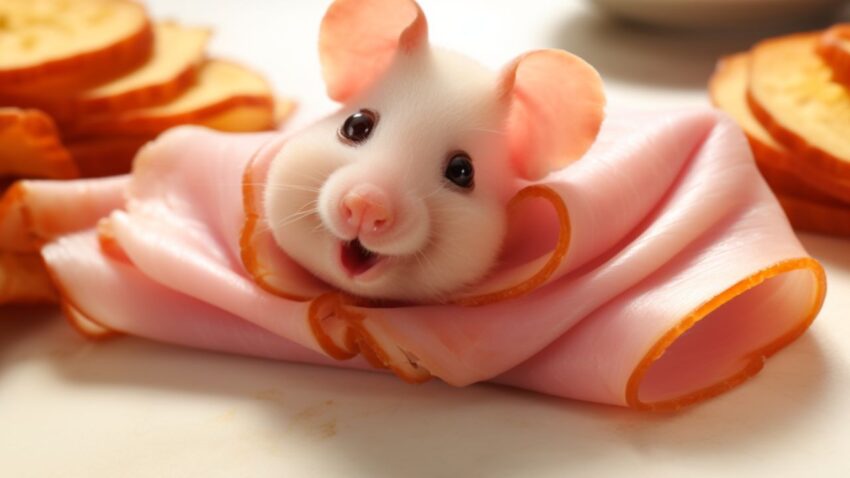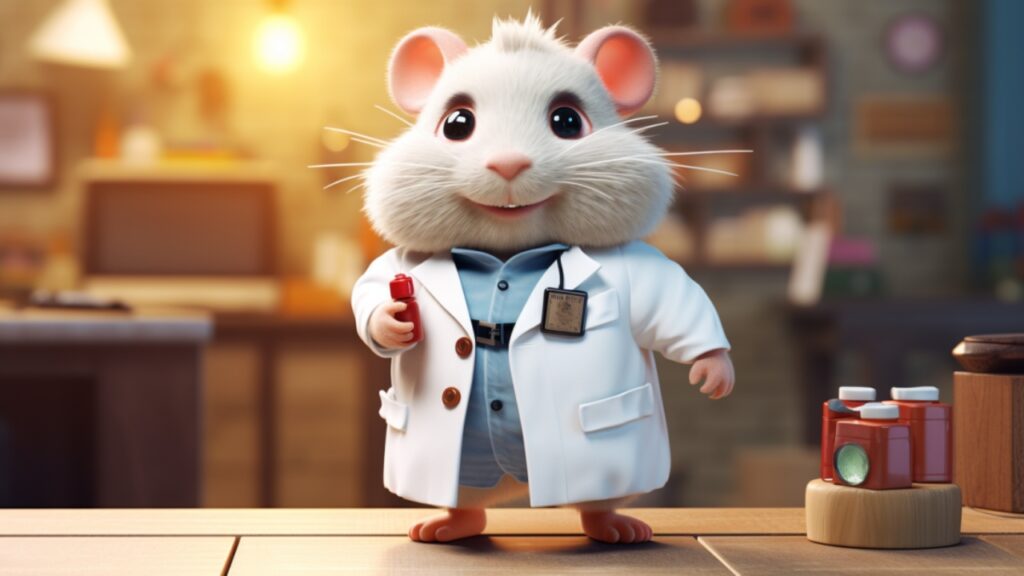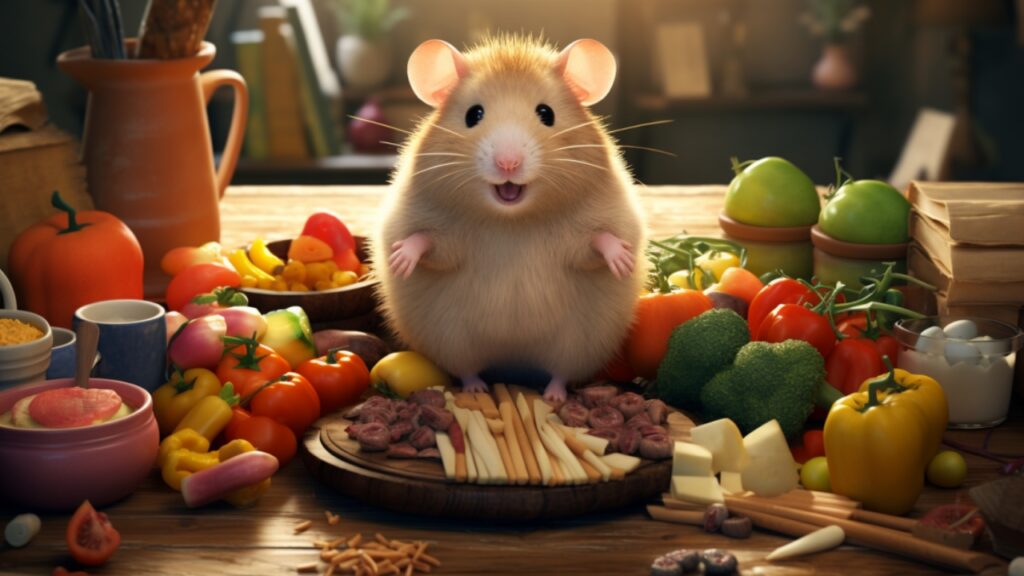TL;DR Summary
Hamsters can consume small amounts of ham as an occasional treat, but it’s not a natural or essential part of their diet. While ham offers some protein, it also contains salt and preservatives which can be harmful to hamsters in larger quantities. Always ensure the ham is plain, without added flavors or seasonings, and serve it in moderation. It’s essential to observe your hamster for any signs of discomfort after consumption. Alternative protein sources like tofu, chicken, or turkey are often safer and more beneficial for hamsters. As always, prioritize your pet’s health and consult with a veterinarian before making significant changes to their diet. Remember, a happy hamster is a wheel-y happy you!
The delightful world of hamsters, with their twitching noses and ever-busy tiny paws, often intersects with human habits and lifestyle. In the quest to ensure our little friends live their best lives, we often find ourselves pondering some unexpectedly quirky questions. One such question, almost poetic in its irony, is whether hamsters can indulge in a bite of ham.
Why This Question Arises Among Hamster Owners
Hamsters, by nature, are curious creatures with an affinity for exploring new tastes and textures. Owners, in their enduring love for these petite pets, often gaze at their dinner plates, wondering which morsels can be shared. With ham being a prevalent and favorite snack among humans, it’s only natural to question its compatibility with a hamster’s diet.
When watching those beady eyes fixate on our foods, many are tempted to share. And why not? Sharing is a gesture of love. However, love for our pets also means ensuring what they consume is safe and beneficial for their health.
The Ironic Conundrum: Ham for Hamsters?
There’s a touch of whimsy in even posing this question. A ‘ham’ster eating ‘ham’ is, without doubt, an ironic conundrum that tickles the funny bone. But beyond the humor lies a genuine concern for the dietary needs and restrictions of these small beings. The similarity in naming brings forward a question dripping with curiosity and, let’s admit it, a dash of amusement. But as we journey through this article, we’ll swap amusement for knowledge, ensuring that by the end, clarity reigns supreme.
The World of Ham: A Quick Overview
Ham, with its succulent flavors and varied textures, has established itself as a staple in many cuisines worldwide. While some view it as a delicacy to be savored during special occasions, others incorporate it into daily meals. But how much do we really know about this popular meat product? Let’s delve into its origins and what it brings to the table nutritionally.
Origins and Processing of Ham
Ham, in its most basic form, refers to a specific cut of meat from the hind leg of a pig. The history of ham dates back thousands of years, with various cultures perfecting their own methods of preservation and flavor enhancement. From the early days of salting and air-drying to the modern processes involving smoking and curing, the transformation of a simple pork cut into ‘ham’ is a fascinating journey of culinary evolution.
The processing of ham often involves curing – a method that uses salt, and sometimes sugar, nitrates, and other ingredients to preserve the meat and enhance its flavor. There are also uncured hams available in markets, which rely on natural preservatives like celery powder. Additionally, hams can be smoked, adding another layer of flavor. These processes not only contribute to the taste and texture of the final product but also play a pivotal role in its shelf life and safety for consumption.
Nutritional Content of Ham for Human Consumption
When it comes to nutrition, ham offers a mixed bag. On the positive side, it’s a robust source of high-quality protein, essential for muscle building and repair. It’s also rich in several vital vitamins and minerals, notably B-vitamins (especially B1, B6, and B12), zinc, potassium, and iron.
However, there’s a flip side to the nutritional story of ham. Due to the curing process, ham tends to be high in sodium, which can be concerning for individuals watching their salt intake. Additionally, some hams, especially those glazed with sugars or honey, can pack more carbohydrates and sugars than one might expect. Processed hams might also contain nitrates and nitrites, used as preservatives, which have been a topic of debate regarding their health implications.
In moderation and chosen wisely, ham can be a flavorful and nutritious addition to the human diet. But as with all foods, it’s crucial to be informed and make choices that align with individual health needs and goals.
Hamster Dietary Essentials
When one thinks of hamsters, the quintessential image that often comes to mind is that of a small, furry creature stuffing its cheeks with food. These endearing rodents, with their insatiable curiosity and energy, have specific dietary needs that play a pivotal role in their overall health and longevity. Ensuring that a hamster receives the right balance of nutrients is crucial for its well-being. So, what exactly should a hamster feast on to thrive?
What Forms the Core of a Hamster’s Diet?
At the heart of a hamster’s diet are seeds and grains. These provide the essential carbohydrates that give these tiny creatures the energy they need to explore, burrow, and of course, run on their beloved wheels. Commercial hamster mixes, often found in pet stores, are formulated to offer a balanced blend of seeds, grains, and sometimes even dehydrated fruits and vegetables.
In addition to commercial mixes, fresh vegetables play an essential role in a hamster’s diet. Foods such as broccoli, carrots, and spinach can offer additional vitamins and minerals that might not be present in sufficient quantities in dry mixes alone. It’s vital, however, to introduce fresh foods gradually and to ensure they’re thoroughly washed to remove any pesticides.
And let’s not forget about protein! In the wild, hamsters consume small insects, which offer them necessary protein. In captivity, this protein can be supplemented through the occasional serving of boiled egg, lean meats, or even mealworms.
The Role of Proteins and Fats in a Hamster’s Nutritional Needs
Proteins are the building blocks of life. For hamsters, they are vital for growth, tissue repair, and overall health. While seeds and grains provide some protein, the addition of animal-based protein sources can ensure that the hamster receives all the essential amino acids it requires.
Fats, on the other hand, are a concentrated source of energy for hamsters. They also play a role in supporting cell function and nutrient absorption. Seeds, especially sunflower and flax seeds, are rich in fats and are often a favorite among hamsters. However, it’s crucial to ensure that these are given in moderation, as an excessive intake can lead to obesity—a common concern in captive hamsters.
In essence, a balanced hamster diet is a delicate dance of carbohydrates, proteins, and fats, complemented by a symphony of vitamins and minerals. Understanding these nutritional intricacies is the key to ensuring that our whiskered friends lead a healthy and happy life.
Dr. Whiskerson’s Observations & Recommendations
The question of whether hamsters can consume ham (or meat, in general) is one that has intrigued many hamster enthusiasts and experts alike. Being an omnivore in the wild, a hamster’s diet comprises both plant-based and animal-based foods. But how does this translate to domesticated hamsters? Let’s delve deeper into this meaty subject.
Hamsters’ Interaction with Meat: What the Science Says
In their natural habitat, hamsters will often feed on insects, which provide them with essential proteins. These proteins play a crucial role in muscle development, tissue repair, and various other bodily functions. Domesticated hamsters, when presented with meat, often show interest, indicating an inherent inclination towards it.
However, the meat we humans consume, such as ham, is processed differently than the raw insects wild hamsters might consume. Ham, in particular, is cured and may contain high levels of salt, preservatives, and other additives. Such additives might not be suitable for a hamster’s digestive system and can potentially lead to health issues. Furthermore, fatty cuts of meat or those with spices and flavorings should be avoided.
The Natural Instincts of Hamsters: Observations in Domestic Settings
While we steer clear of citing fictional studies or endorsements, observing domesticated hamsters can offer valuable insights. When given a choice, hamsters often exhibit a preference for fresh foods, whether it’s veggies, fruits, or lean meats. This behavior echoes their wild counterparts who forage for a varied diet.
It’s not uncommon for hamster owners to notice their pets showing interest in lean chicken or turkey. If one chooses to offer meat, it should be cooked plainly, without any salt, spices, or additives. Always ensure it’s in small, manageable portions. It’s also essential to monitor your hamster for any changes in behavior or digestive discomfort after introducing any new food item.
In conclusion, while hamsters have an inherent inclination towards meat, it’s vital to ensure that what they’re consuming is safe and beneficial for them. Processed meats like ham may not be the best choice, but with careful consideration, other meat options can be introduced. Always prioritize your pet’s health and well-being.
Potential Risks and Concerns
Introducing new food items into your hamster’s diet, especially those not typically associated with their natural eating habits, can be a matter of considerable deliberation. With ham and other meats, there are specific concerns to consider. Let’s dive into these potential risks and how they might affect our furry friends.
Sodium and Preservatives in Ham
Ham, especially the kind consumed by humans, undergoes a curing process that involves salt and sometimes other preservatives. While sodium is an essential mineral that supports muscle and nerve function, excessive amounts can be detrimental. Hamsters have tiny bodies, and their systems aren’t equipped to handle the high sodium levels found in many processed foods, including ham. Prolonged consumption or ingestion of large amounts can lead to dehydration, high blood pressure, and kidney-related issues in hamsters. Furthermore, other preservatives and additives, often used to enhance flavor or extend shelf life, can pose additional health risks.
Choking Hazards and Portion Sizes
The size and texture of the food we give to our hamsters are as important as its nutritional content. Ham, being a relatively dense meat, can pose a choking risk if not adequately sized for the hamster. Even small, bite-sized pieces can become a hazard if they’re too tough or if the hamster tries to hoard them in their cheek pouches. Always be mindful of the portion sizes and the consistency of the meat. If you do decide to give your hamster a taste, ensure the ham is finely chopped and free from tough or stringy bits.
Digestive Implications of Meat for Hamsters
While wild hamsters might consume insects and small animals, domesticated hamsters are primarily used to commercial feed and occasional fresh treats. Their digestive systems have evolved accordingly. Introducing meat, especially in large quantities, can disrupt their digestive balance. This disruption can lead to stomach upsets, diarrhea, or constipation. It’s essential to monitor your hamster’s droppings and general behavior after introducing any new food, especially meat. Changes in the consistency, color, or frequency of droppings can be indicative of a digestive issue and warrant caution.
In summation, while the idea of sharing some of our food with our beloved pets might be tempting, it’s always essential to prioritize their health and well-being. With ham and other meats, the potential risks often outweigh the benefits. Always approach with caution, armed with knowledge, and an observant eye.
Alternative Viewpoints
When venturing into the world of hamster nutrition, one can encounter a myriad of opinions and experiences. While our research and expertise offer one perspective, it’s also valuable to consider alternative viewpoints. Let’s explore some common sentiments within the broader hamster care community and highlight some anecdotal tales that have emerged over time.
Common Sentiments on Hamster Diet
Across various hamster care forums, blogs, and communities, the topic of meat in a hamster’s diet frequently emerges. Some argue that since wild hamsters consume a variety of foods, including occasional animal proteins, domesticated ones might also benefit from such a diverse diet. Others emphasize sticking to commercially available hamster feeds, supplemented with vegetables, fruits, and grains, given that these foods have been specifically formulated for the needs of captive hamsters.
Tales from the Hamster Community: Anecdotal Evidences
Personal experiences form a significant portion of the knowledge pool in pet communities. Many hamster owners have shared their stories regarding offering ham or other meats to their pets. Some recount positive experiences, mentioning their hamsters’ evident delight in nibbling on a tiny ham piece. Others express caution, noting adverse reactions or suggesting that any meat introduction should be done gradually and in minimal amounts.
While anecdotal evidences provide invaluable insights, they should be approached with caution. Every hamster is unique, and what works for one might not necessarily be suitable for another. It’s always best to introduce new foods in moderation, keeping a keen eye on any changes in behavior or health.
In the vast realm of hamster care, diverse opinions and experiences can guide and inform. However, the primary objective remains unchanged: ensuring the well-being of our furry companions.
Whisker Tips
Navigating the intricacies of hamster nutrition can be a daunting task, especially when introducing new and potentially controversial foods like ham. As always, in our “Whisker Tips” segment, we strive to provide you with some practical, hands-on advice that can help you make informed decisions for your furry friend. Let’s delve into the how-tos and precautions surrounding ham in a hamster’s diet.
If Considering Ham, How to Introduce It Safely
If you’re pondering the idea of giving ham a trial in your hamster’s diet, here are some steps to ensure a smooth introduction:
- Choose Wisely: Opt for low-sodium, preservative-free ham. Many store-bought hams have high salt content and additives that aren’t suitable for hamsters.
- Start Small: Begin with a tiny, pea-sized amount. It’s always better to err on the side of caution and gauge your hamster’s reaction to such a minute quantity.
- Observe and Evaluate: After the initial offering, monitor your hamster’s behavior and health. Any sudden or drastic changes might indicate that ham isn’t the best fit for your hamster’s dietary needs.
- Clean Up Promptly: Ensure that any uneaten ham is removed from the cage promptly to avoid spoilage or the attraction of unwanted pests.
Signs of Discomfort or Distress to Watch Out For
When introducing any new food item, it’s crucial to be on the lookout for any signs that might indicate your hamster isn’t taking well to the change. Here are some signals of discomfort or distress:
- Change in Appetite: A sudden loss of appetite can be a red flag.
- Digestive Issues: Diarrhea, constipation, or any other unusual stool changes can be indicative of digestive discomfort.
- Behavioral Changes: A usually active hamster becoming lethargic or vice versa can be concerning.
- Physical Discomfort: Look out for signs like excessive scratching, signs of swelling, or discomfort in the mouth or throat area, possibly due to choking.
- Avoidance: If your hamster completely avoids the ham or any other new food you introduce, it might be best to reconsider its inclusion in the diet.
In the adventurous journey of pet ownership, being well-informed and observant ensures a safe and happy experience for both you and your hamster.
Conclusion: Ham for Hamsters – A Delight or a Disaster?
As we come to the end of our deep dive into the topic of ham for hamsters, it’s time to reflect upon what we’ve learned and discern whether this food item is a suitable inclusion in a hamster’s diet. From understanding the origins and nutritional content of ham for humans, to thoroughly examining the dietary essentials of hamsters, and weighing potential risks, we’ve endeavored to present a well-rounded view.
Summarizing the Research and Observations:
- Ham’s Nutritional Profile for Humans: Ham, primarily a source of protein and fat for humans, can also be laden with sodium and preservatives, depending on its processing.
- Hamster’s Dietary Essentials: A balanced diet for hamsters primarily consists of seeds, grains, and occasional fresh produce, with proteins and fats playing a vital role.
- Risks and Concerns: High sodium content and preservatives in many processed hams, potential choking hazards due to inappropriate portion sizes, and potential digestive implications have been identified as primary concerns.
- Alternative Viewpoints & Anecdotes: While some hamster owners have tried and vouched for offering ham, others have voiced concerns or opted to refrain entirely.
- Whisker Tips Takeaway: If one chooses to venture into offering ham to their hamster, doing so with caution, starting with tiny portions, and being vigilant about observing the hamster’s reaction is crucial.
In the light of all this information, the answer isn’t as black and white as we’d hope. While ham might be a delight for some hamsters, under specific conditions and precautions, it could be a potential disaster for others if not introduced correctly or if consumed in larger quantities. The onus, dear reader, rests on you to make an informed decision, backed by vigilant observation and utmost care.
And as we always say, whether you choose to include ham or any other new food in your hamster’s diet, the end goal remains the same: the health and happiness of your furry friend. Remember, a happy hamster is a wheel-y happy you!











